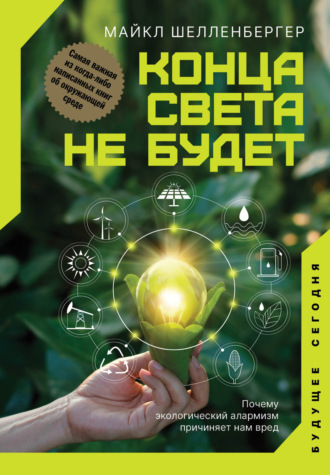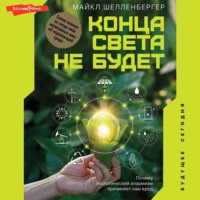
Полная версия
Конца света не будет. Почему экологический алармизм причиняет нам вред
312
“Living Planet Index,” 2018, Zoological Society of London and WWF, www.livingplanetindex.org.
313
Hannah Behrendt, Carole Megevand, and Klas Sander, “Deforestation Trends in the Congo Basin: Reconciling Economic Growth and Forest Protection,” Working Paper 5, “Wood-Based Biomass Energy,” Regional Commission in Charge of Forestry in Central Africa, April 2013, https://www.profor.info/sites/profor.info/files/Biomass%20Energy_Sectoral%20Report_Final%5Bweb%5D_may13_0.pdf.
314
Mark Jenkins, “Who Murdered the Virunga Gorillas?” National Geographic, July 2008, www.nationalgeographic.com.
315
Mark Jenkins, “Who Murdered the Virunga Gorillas?” National Geographic, July 2008, www.nationalgeographic.com.
316
Mark Jenkins, “Who Murdered the Virunga Gorillas?” National Geographic, July 2008, www.nationalgeographic.com.
317
Holly Dranginis, “Congo’s Charcoal Cartel,” Foreign Affairs, May 12, 2016, https://www.foreignaffairs.com.
318
Behrendt et al., “Deforestation Trends in the Congo Basin,” 1.
319
Sophie Lewisohn, “Virunga: Preserving Africa’s National Parks Through People-Centred Development,” Capacity4dev, European Union, April 3, 2018, https://europa.eu/capacity4dev/articles/virunga-preserving-africas-national-parks-through-people-centred-development. Amy Yee, “The Power Plants That May Save a Park, and Aid a Country,” New York Times, August 30, 2017, https://www.nytimes.com.
320
Andrew Plumptre (senior scientist, Africa Program, Wildlife Conservation Society) in discussion with the author, February 10, 2015, and November 6, 2019.
321
Michael J. Kavanagh (journalist) in discussion with the author, November 29, 2014.
322
Abe Streep, “The Belgian Prince Taking Bullets to Save the World’s Most Threatened Park,” Outside, November 5, 2014, https://www.outsideonline.com.
323
Abe Streep, “The Belgian Prince Taking Bullets to Save the World’s Most Threatened Park,” Outside, November 5, 2014, https://www.outsideonline.com.
324
Jeffrey Gettlemen, “Oil Dispute Takes a Page from Congo’s Bloody Past,” New York Times, November 15, 2014, https://www.nytimes.com.
325
George Schaller, The Year of the Gorilla (Chicago: University of Chicago Press, 1988), 3.
326
George Schaller, The Year of the Gorilla (Chicago: University of Chicago Press, 1988), 8.
327
Paul Raffaele, “Gorillas in Their Midst,” Smithsonian, October 2007, https://www.smithsonianmag.com.
328
Andrew J. Plumptre et al., “Conservation Action Plan for the Albertine Rift” (unpublished report for Wildlife Conservation Society and its partners, 2016), 5, 7.
329
“What I was hearing in the mid-90s and early 2000s while working for IGCP was that the conflict in the DRC was all about greed and people wanting to exploit the minerals. Others said it was all about grievances and the Rwandan conflict. Doing my PhD I came to the conclusion that both aspects are at play, but the causes of the conflict stem from grievances.” Michael Shellenberger, “Violence, the Virungas, and Gorillas: An Interview with Conservationist Helga Rainer,” Breakthrough Institute, November 20, 2014, https://thebreakthrough.org/issues/conservation/violence-the-virungas-and-gorillas.
330
Mark Dowie, Conservation Refugees: The Hundred-Year Conflict Between Global Conservation and Native Peoples (Cambridge, MA: MIT Press, 2009), xxi.
331
Mahesh Rangarajan and Ghazala Shahabuddin, “Displacement and Relocation from Protected Areas,” Conservation and Society 4, no. 3 (September 2006): 359, https://www.conservationandsociety.org.
332
Mark Dowie, Conservation Refugees: The Hundred-Year Conflict Between Global Conservation and Native Peoples.
333
Ibid., xxvi.
334
Sammy Zahran, Jeffrey G. Snodgrass, David G. Maranon et al., “Stress and Telomere Shortening Among Central Indian Conservation Refugees,” Proceedings of the National Academy of Sciences of the United States of America 112, no. 9 (March 3, 2015): E928–E936, https://doi.org/10.1073/pnas.1411902112.
335
A. J. Plumptre, A. Kayitare, H. Rainer et al., “The Socio-economic Status of People Living near Protected Areas in the Central Albertine Rift,” Albertine Rift Technical Reports 4 (2004), https://www.researchgate.net/publication/235945000_Socioeconomic_status_of_people_in_the_Central_Albertine_Rift, 28.
336
Alastair McNeilage (primatologist, Wildlife Conservation Society) in discussion with the author, February 5, 2015.
337
Plumptre et al., “The Socio-economic Status of People Living near Protected Areas in the Central Albertine Rift,” 98.
338
Michael Shellenberger, “Postcolonial Gorilla Conservation: An Interview with Ecologist Sarah Sawyer,” Breakthrough Institute, November 19, 2014, https://thebreakthrough.org/issues/conservation/postcolonial-gorilla-conservation.
339
Michael Shellenberger, “Postcolonial Gorilla Conservation: An Interview with Ecologist Sarah Sawyer,” Breakthrough Institute, November 19, 2014, https://thebreakthrough.org/issues/conservation/postcolonial-gorilla-conservation.
340
Andrew Plumptre (senior scientist, Africa Program, Wildlife Conservation Society) in discussion with the author, November 6, 2019.
341
“2019–2020 Gorilla Tracking Permit Availability Uganda/Rwanda,” Kisoro Tours Uganda, https://kisorotoursuganda.com/2019-2020-gorilla-tracking-permit-availability-uganda-rwanda. Uganda remains a relative bargain at just $600.
342
Michael Shellenberger, “Postcolonial Gorilla Conservation: An Interview with Ecologist Sarah Sawyer,” https://thebreakthrough.org/issues/conservation/violence-the-virungas-and-gorillas.
343
Plumptre et al., “The Socio-economic Status of People Living near Protected Areas in the Central Albertine Rift,” Albertine Rift Technical Reports 4 (2004): 116, https://albertinerift.wcs.org.
344
Alastair McNeilage (primatologist, Wildlife Conservation Society) in discussion with the author, February 5, 2015.
345
Andrew Plumptre (senior scientist, Africa Program, Wildlife Conservation Society) in discussion with the author, February 10, 2015, and November 6, 2019.
346
Michael Shellenberger, “Violence, the Virungas, and Gorillas: An Interview with Conservationist Helga Rainer.”
347
Andrew Plumptre et al., “The Socio-economic Status of People Living near Protected Areas in the Central Albertine Rift,” 25.
348
Michael Shellenberger, “Postcolonial Gorilla Conservation: An Interview with Ecologist Sarah Sawyer.”
349
Andrew Plumptre (senior scientist, Africa Program, Wildlife Conservation Society) in discussion with the author, February 10, 2015.
350
Andrew Plumptre (senior scientist, Africa Program, Wildlife Conservation Society) in discussion with the author, November 6, 2019.
351
Andrew Plumptre (senior scientist, Africa Program, Wildlife Conservation Society) in discussion with the author, November 6, 2019.
352
Andrew Plumptre (senior scientist, Africa Program, Wildlife Conservation Society) in discussion with the author, November 6, 2019.
353
“Once accustomed to harvesting game with traditional weapons for their own community’s use, expelled natives often buy rifles, re-enter their former hunting grounds, and begin poaching larger numbers of the same game for the growing ‘bush meat,’ or the meat from wild animals, trade, which like almost everything else has gone global,” noted the environmental journalist. In Cameroon in 2003, “impoverished and embittered refugees invaded both reserves and plundered their natural resources.” Dowie, Conservation Refugees, xxvi – xxvii.
354
Andrew Plumptre (senior scientist, Africa Program, Wildlife Conservation Society) in discussion with the author, February 10, 2015.
355
Andrew Plumptre (senior scientist, Africa Program, Wildlife Conservation Society) in discussion with the author, November 6, 2019.
356
Shannon Sims, “After Violence, Congo’s Virunga National Park Closes for the Year,” New York Times, June 14, 2018, https://www.nytimes.com.
357
Jason Burke, “Ranger Killed Weeks After Reopening of Virunga National Park,” The Guardian, March 8, 2019, www.theguardian.com.
358
Mamy Bernadette Semutaga, interviewed by Caleb Kabanda, December 11, 2019.
359
Sunil Nautiyal and Harald Kaechele, “Fuel Switching from Wood to LPG Can Benefit the Environment,” Environmental Impact Assessment Review 28, no. 8 (November 2008): 523–32, https://doi.org/10.1016/j.eiar.2008.02.004.
360
Alastair McNeilage (primatologist, Wildlife Conservation Society) in discussion with the author, February 5, 2015.
361
Alastair McNeilage (primatologist, Wildlife Conservation Society) in discussion with the author, February 5, 2015.
362
Alastair McNeilage (primatologist, Wildlife Conservation Society) in discussion with the author, February 5, 2015.
363
Alastair McNeilage (primatologist, Wildlife Conservation Society) in discussion with the author, February 5, 2015.
364
Alastair McNeilage (primatologist, Wildlife Conservation Society) in discussion with the author, February 5, 2015.
365
Alastair McNeilage (primatologist, Wildlife Conservation Society) in discussion with the author, February 5, 2015.
366
Alastair McNeilage (primatologist, Wildlife Conservation Society) in discussion with the author, February 5, 2015.
367
Michael J. Kavanagh (journalist) in discussion with the author, November 29, 2014.
368
Amy Yee, “The Power Plants That May Save a Park, and Aid a Country,” New York Times, August 30, 2017, https://www.nytimes.com.
369
Amy Yee, “The Power Plants That May Save a Park, and Aid a Country,” New York Times, August 30, 2017, https://www.nytimes.com.
370
“History of Hoover,” Arizona Power Authority, accessed January 20, 2020, http://www.powerauthority.org/about-us/history-of-hoover
371
Elizabeth Paton, “Extinction Rebellion Takes Aim at Fashion,” New York Times, October 6, 2019, https://www.nytimes.com.
372
Olivia Petter, “Extinction Rebellion: ‘Why We’re Targeting London Fashion Week,” The Independent, September 12, 2019, https://www.independent.co.uk.
373
Elizabeth Paton, “Extinction Rebellion Takes Aim at Fashion,” New York Times, October 6, 2019, https://www.nytimes.com.
374
Elizabeth Paton, “Extinction Rebellion Takes Aim at Fashion,” New York Times, October 6, 2019, https://www.nytimes.com.
375
XR Boycott Fashion, “On Friday 26th of July, we wrote to the British Fashion Council begging them to cancel London Fashion Week,” Facebook, August 4, 2019, https://www.facebook.com/XRBoycottFashion/posts/113234513352496?__tn__=K-R.
376
“Pulse of the Fashion Industry,” Global Fashion Agenda, Boston Consulting Group and Sustainable Apparel Coalition, 2019, accessed October 26, 2019, https://www.globalfashionagenda.com/pulse-2019-update.
377
Elizabeth Paton, “Extinction Rebellion Takes Aim at Fashion.”
378
Sarah Anne Hughes, “Greenpeace Protests Barbie at Mattel Headquarters,” «The Washington Post», June 8, 2011, https://www.washingtonpost.com.
379
Sarah Anne Hughes, “Greenpeace Protests Barbie at Mattel Headquarters,” «The Washington Post», June 8, 2011, https://www.washingtonpost.com.
380
Steven Greenhouse, “Nike Supports Women in Its Ads but Not Its Factories, Groups Say,” New York Times, October 26, 1997, https://www.nytimes.com.
381
Jeff Ballinger, “Nike, Sexual Harassment and the ‘Corporate Social Responsibility’ Racket: How the Company Shut Down the New York Times,” Washington Babylon, November 9, 2017, https://washingtonbabylon.com.
382
Jeff Ballinger, “Nike, Sexual Harassment and the ‘Corporate Social Responsibility’ Racket: How the Company Shut Down the New York Times,” Washington Babylon, November 9, 2017, https://washingtonbabylon.com.
383
“Statement on 2019 Copenhagen Fashion Summit,” Union of Concerned Researchers in Fashion, May 5, 2019, accessed October 26, 2019, http://www.concernedresearchers.org/ucrf-on-2019-copenhagen-fashion-summit. See also, “The changes we are seeing from some brands remain extremely superficial,” said one XR activist. Paton, “Extinction Rebellion Takes Aim at Fashion.”
384
Syarifah Nur Aida (journalist, Ipeh) in discussion with the author, June 8, 2015.
385
Suparti (factory worker) in discussion with the author, June 8–9, 2015.
386
Suparti (factory worker) in discussion with the author, June 8–9, 2015.
387
Xiaoping Liu, Guohua Hu, Yimin Chen et al., “High-Resolution Multitemporal Mapping of Global Urban Land Using Landsat Images Based on the Google Earth Engine Platform,” Remote Sensing of Environment 209 (May 2018): 227–39, https://doi.org/10.1016/j.rse.2018.02.055.
388
Christopher D. Elvidge, Benjamin T. Tuttle, Paul C. Sutton et al., “Global Distribution and Density of Constructed Impervious Surfaces,” Sensors 7, no. 9 (2007): 1962-79, https://dx.doi.org/10.3390%2Fs7091962.
389
FAO finds reforestation in Europe, Asia, North America, and the Caribbean. Central America, South America, Africa, and Oceania are still deforesting. The global rate of deforestation has been cut by over half since 1990, from 7.3 million to 3.3 million hectares per year as reforestation accelerated. “Data,” FAO.
390
“Data,” Food and Agriculture Organization of the United Nations, http://www.fao.org/faostat/en/#data. Russell Warman, “Global Wood Production from Natural Forests Has Peaked,” Biodiversity and Conservation 23, no. 5 (2014): 1063–78, https://doi.org/10.1007/s10531-014-0633-6.
391
FAO projects that the amount of arable land and permanent crop area will stay nearly flat through 2050, as detailed in its report on the subject. Nikos Alexandratos and Jelle Bruinsma, “World Agriculture Towards 2030/2050: The 2012 Revision,” ESA Working Paper no. 12-03, Agricultural Development Economics Division, Food and Agriculture Organization of the United Nations, June 2012, http://www.fao.org/3/a-ap106e.pdf.
392
Per FAO, global per capita kilocalorie production was 2,196 in 1961 and 2,884 in 2013. Along with the global population increase from 3.1 billion to 7.2 billion between 1961 and 2013, global food production has tripled. The amount of global land used for agriculture increased from 4.5 billion to 4.8 billion hectares over the same period. “Data,” FAO.
393
Per FAO, global per capita kilocalorie production was 2,196 in 1961 and 2,884 in 2013. Along with the global population increase from 3.1 billion to 7.2 billion between 1961 and 2013, global food production has tripled. The amount of global land used for agriculture increased from 4.5 billion to 4.8 billion hectares over the same period. “Data,” FAO.
394
Per FAO, global per capita kilocalorie production was 2,196 in 1961 and 2,884 in 2013. Along with the global population increase from 3.1 billion to 7.2 billion between 1961 and 2013, global food production has tripled. The amount of global land used for agriculture increased from 4.5 billion to 4.8 billion hectares over the same period. “Data,” FAO.
395
Changes in Farm Production and Efficiency: A Summary Report, United States Department of Agriculture, Statistical Bulletin 233 (Washington, DC: USDA, 1959), 12–13.
396
A. Bala, “Nigeria,” Global Yield Gap and Water Productivity Atlas, http://www.yieldgap.org/en/web/guest/nigeria. Nikolai Beilharz, “New Zealand farmer sets new world record for wheat yield,” ABC News, April 3, 2017, https://www.abc.net.au. Matthew B. Espe, Haishun Yang, Kenneth G. Cassman et al., “Estimating Yield Potential in Temperate High-Yielding, Direct-Seeded US Rice Production Systems,” Field Crops Research 193 (July 2016): 123–32, https://doi.org/10.1016/j.fcr.2016.04.003. Though average yields for some crops such as wheat have plateaued, there is still more room for them to increase. In 2017, a farmer in New Zealand produced an astonishing eight times as much wheat as the Australian average and five times as much as the global average.
397
FAO, The future of food and agriculture – Alternative pathways to 2050 (Rome: Food and Agriculture Organization of the United Nations, 2018), 76–77.
398
Nathaniel D. Mueller, James S. Gerber, Matt Johnston et al., “Closing Yield Gaps Through Nutrient and Water Management,” Nature 490 (2012): 254–57, https://doi.org/10.1038/nature11420.
399
Deepak K. Ray, “Increasing Global Crop Harvest Frequency: Recent Trends and Future Directions,” Environmental Research Letters 8 (2013), https://iopscience.iop.org/article/10.1088/1748-9326/8/4/044041/pdf.
400
Luis Lassaletta, Gilles Billen, Bruna Grizzetti et al., “50 Year Trends in Nitrogen Use Efficiency of World Cropping Systems: The Relationship between Yield and Nitrogen Input to Cropland,” Environmental Research Letters 9, no. 10 (October 2014), https://doi.org/10.1088/1748-9326/9/10/105011.
401
“Changes in Erosion 1982–1997,” U.S. Department of Agriculture, January 4, 2001, https://www.nrcs.usda.gov/wps/portal/nrcs/detail/soils/ref/?cid=nrcs143_013911. FAO data on crop yields show almost every major crop increasing in yield in the United States between 1982 and 1997. “Data,” FAO.
402
Suparti (factory worker) in discussion with the author, June 8–9, 2015.
403
James C. Riley, “Estimates of Regional and Global Life Expectancy, 1800–2001,” Population and Development Review 31, no. 3 (2005), 537–543, accessed January 16, 2020, www.jstor.org/stable/3401478, “World Population Prospects 2019: Highlights,” United Nations, accessed January 14, 2020, https://www.un.org/development/desa/publications/world-population-prospects-2019-highlights.html.
404
Max Roser, Hannah Ritchie, and Bernadeta Dadonaite, “Child and Infant Mortality,” Our World in Data, November 2019, https://ourworldindata.org/child-mortality. The world series for 1800 to 1960 was calculated by the authors on the basis of the Gapminder estimates of child mortality and the Gapminder series on population by country. For each estimate in that period a population-weighted global average was calculated. The 2017 child mortality rate was taken from the 2019 update of World Bank data.
405
Steven Pinker, Enlightenment Now: The Case for Reason, Science, Humanism, and Progress (New York: Penguin Publishing Group, 2019), 86–87.
406
“PovcalNet: An Online Analysis Tool for Global Poverty Monitoring,” World Bank Group, accessed October 29, 2019, http://iresearch.worldbank.org/PovcalNet/home.aspx.
407
Max Roser, Hannah Ritchie, and Esteban Ortiz-Ospina, “World Population Growth,” Our World In Data, May 2019, accessed January 16, 2020, https://ourworldindata.org/world-population-growth.
408
Max Roser, Hannah Ritchie, and Esteban Ortiz-Ospina, “World Population Growth,” Our World In Data, May 2019, accessed January 16, 2020, https://ourworldindata.org/world-population-growth.







